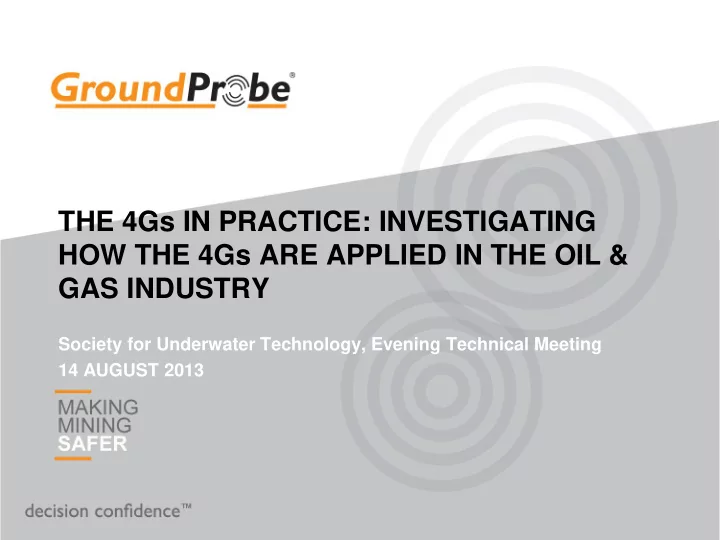

THE 4Gs IN PRACTICE: INVESTIGATING HOW THE 4Gs ARE APPLIED IN THE OIL & GAS INDUSTRY Society for Underwater Technology, Evening Technical Meeting 14 AUGUST 2013
GEOPHYSICS & PORT DEVELOPMENTS – EXPLORING MARINE & TRANSITION ZONES Dr Kathleen McMahon Senior Geophysicist, GroundProbe Commercial in Confidence – 2
SUMMARY WHY USE GEOPHYSICS? MARINE GEOPHYSICAL TECHNOLOGIES THE PROS & CONS EXAMPLE RESULTS & CASE STUDIES Commercial in Confidence – 3
WHY USE GEOPHYSICS? Geophysics is a useful tool for pre-development investigations in the marine environment and within the onshore/offshore transition zone What? Dredging, Piling, Causeways, Reclamation, Pipelines When? Pre-planning, Pre- or post-drilling activities Where? Near shore (shallow) marine, Land, Transition zones Commercial in Confidence – 4
WHY USE GEOPHYSICS? Why? Geophysics can assist with: Determination of suitable locations for berths, turning pockets and approach channels Identifying dredgeable areas Providing geotechnical or geohazard information – e.g. impediments to dredging such as hard ridges Providing layer information & depth to bedrock Commercial in Confidence – 5
WHY USE GEOPHYSICS? Products: Layer mapping of geophysical boundaries along transects, and 3D surface modelling Correlation with lithology data (borehole/vibrocore) Geophysical unit characterisation – geophysical properties, thickness/depth, dominant lithologies Volume estimation Commercial in Confidence – 6
MARINE GEOPHYSICAL TECHNOLOGIES Marine Surveying in Shallow (<30 m) Water: Bathymetry & Side Scan Sonar Magnetics Seismic Reflection Seismic Refraction Electrical Methods Transition Zone & Land-based surveying: Seismic Methods – Refraction, MASW, Reflection Electrical Methods – Electrical Resistivity Imaging (ERI) Electromagnetic (EM) Methods – Shallow EM And more… Airborne Electromagentics Commercial in Confidence – 7
THE PROS & CONS TYPE OF TECHNOLOGY POSITIVES NEGATIVES METHOD Seismic Reflection Seismic Provides structural Does not produce (CSP – Continuous information (layers, hardness Seismic Profiling) depths) information Fast acquisition Seismic Refraction Seismic Established Cannot detect correlation velocity inversions between P-wave (low velocity layers velocity and between higher dredgeability velocity layers) MASW (Multi- Seismic Can detect velocity Horizontal channel Analysis of inversions resolution reduced Surface Waves) . Frequency- dependant Resistivity Electrical Maps porosity and Does not produce clay variations hardness information Low resolution Commercial in Confidence – 8
THE PROS & CONS TYPE OF TECHNOLOGY POSITIVES NEGATIVES METHOD Magnetics Potential Fields Detects iron Does not provide (metallic objects) depth discrimination Can map magnetic geologic units Side Scan Sonar Sonar Detects seafloor Seafloor surface features e.g. sand only structures, coral, obstructions MBES (Multi-Beam Bathymetry Provides detailed Seafloor surface Echo-Sounder) bathymetry only . SkyTEM Airborne Fast coverage No hardness Electromagnetics information Low resolution Commercial in Confidence – 9
MARINE SEISMIC Seismic Reflection Commercial in Confidence – 10
MARINE SEISMIC Seismic Refraction vs MASW Commercial in Confidence – 11
MARINE SEISMIC – PORT DEVELOPMENT CASE STUDY 1 Defining layers & stiffness/velocity variations Commercial in Confidence – 12
MARINE SEISMIC – PORT DEVELOPMENT CASE STUDY 1 Defining layers & stiffness/velocity variations Commercial in Confidence – 13
MARINE SEISMIC – PORT DEVELOPMENT CASE STUDY 1 0ms 0mBSL ≈ 10mBSL 80ms 0km 1km Commercial in Confidence – 14
MARINE SEISMIC – PORT DEVELOPMENT CASE STUDY 1 Dredgeability DREDGING P-WAVE COLOUR (IN CHARACTERI VELOCITY IMAGE) STICS 1530 – 1900 Easily dredged with GREEN a TSHD 1 1900 – 2500 Easily dredged with YELLOW a CSD 2 2500 – 4000 Dredge with ORANGE difficulty with a . CSD 2 > 4000 Blasting required RED 1 TSHD - Trailing Suction Hopper Dredger 2 CSD - Cutting Suction Dredger Commercial in Confidence – 15
MARINE SEISMIC – PORT DEVELOPMENT CASE STUDY 2 3D Surfaces, Volumes, Layer Characterisation Commercial in Confidence – 16
MARINE SEISMIC – PORT DEVELOPMENT CASE STUDY 2 3D Surfaces, Volumes, Layer Characterisation Commercial in Confidence – 17
MARINE SEISMIC – PORT DEVELOPMENT CASE STUDY 2 3D Surfaces, Volumes, Layer Characterisation Commercial in Confidence – 18
SHALLOW MARINE AND NEAR SHORE RESISTIVITY Onshore & Offshore Electrical Resistivity Imaging Commercial in Confidence – 19
AIRBORNE ELECTROMAGNETICS OVER MARINE- LAND TRANSITION Mapping clays & fresh vs saline groundwater Clay lens Fresh water saturated Saline water saturated Commercial in Confidence – 20
THANK YOU Commercial in Confidence – 21
Recommend
More recommend